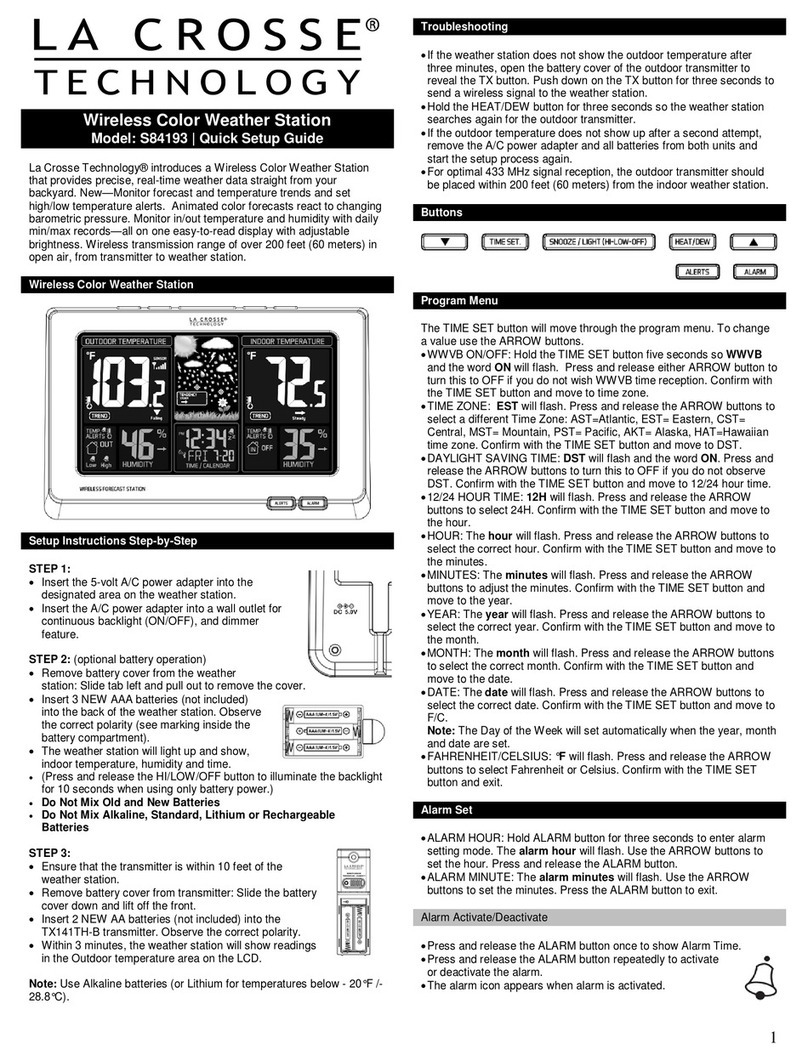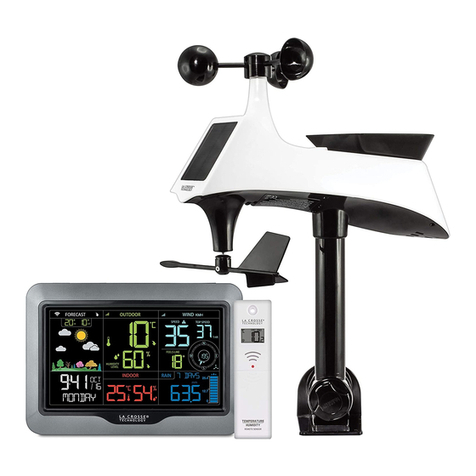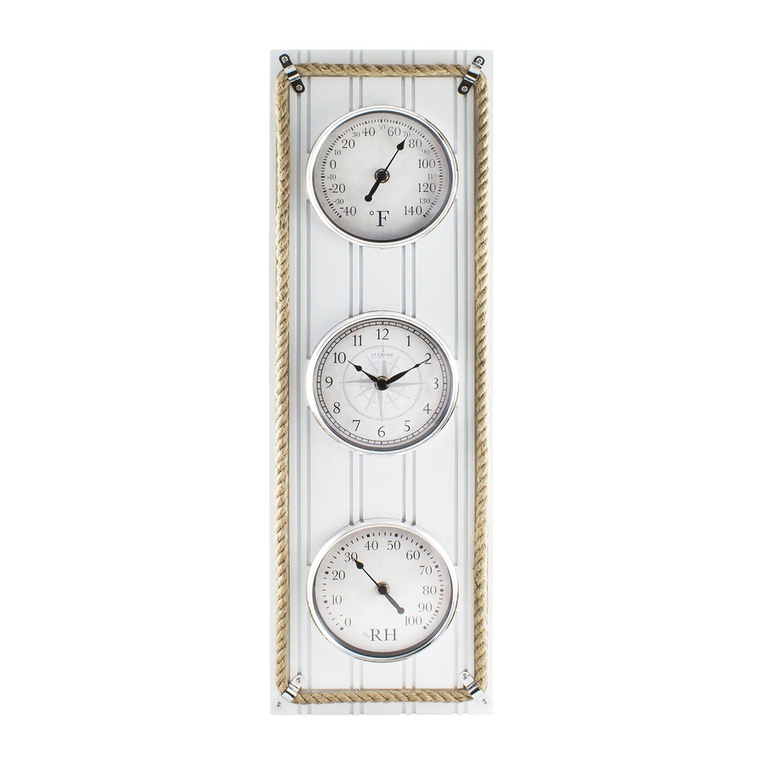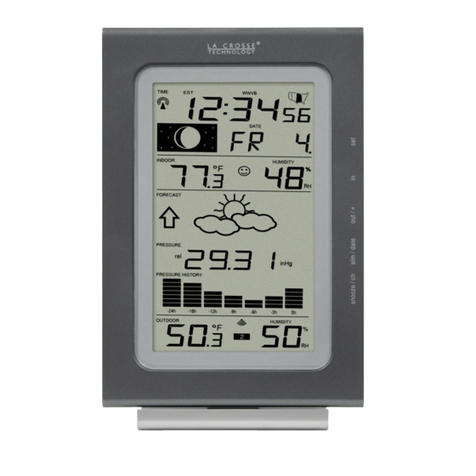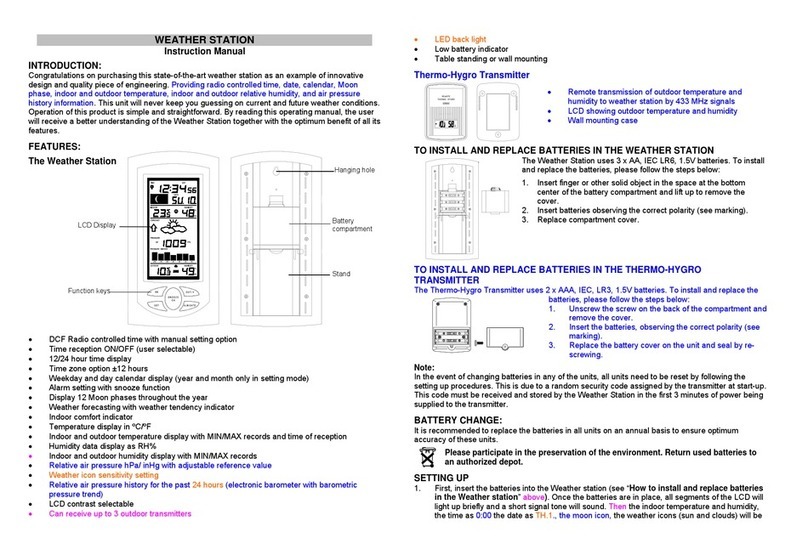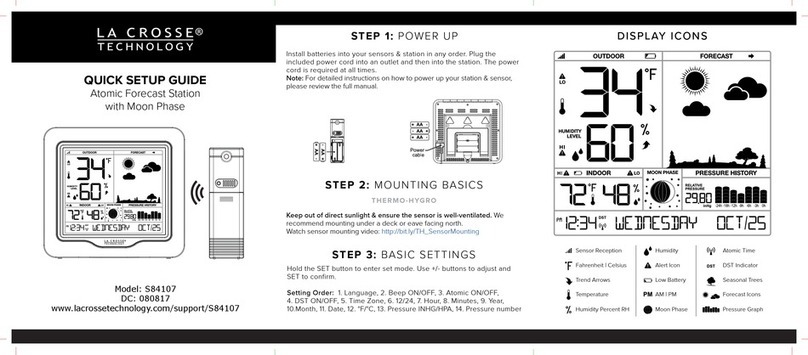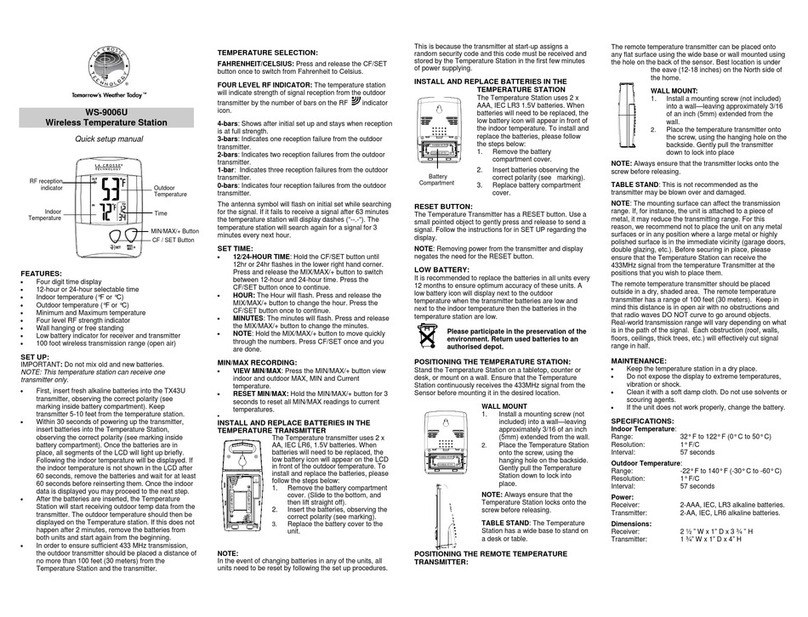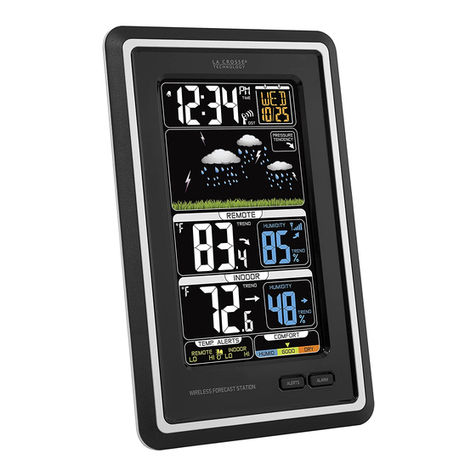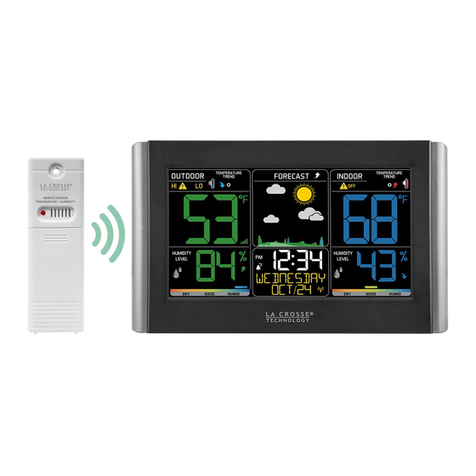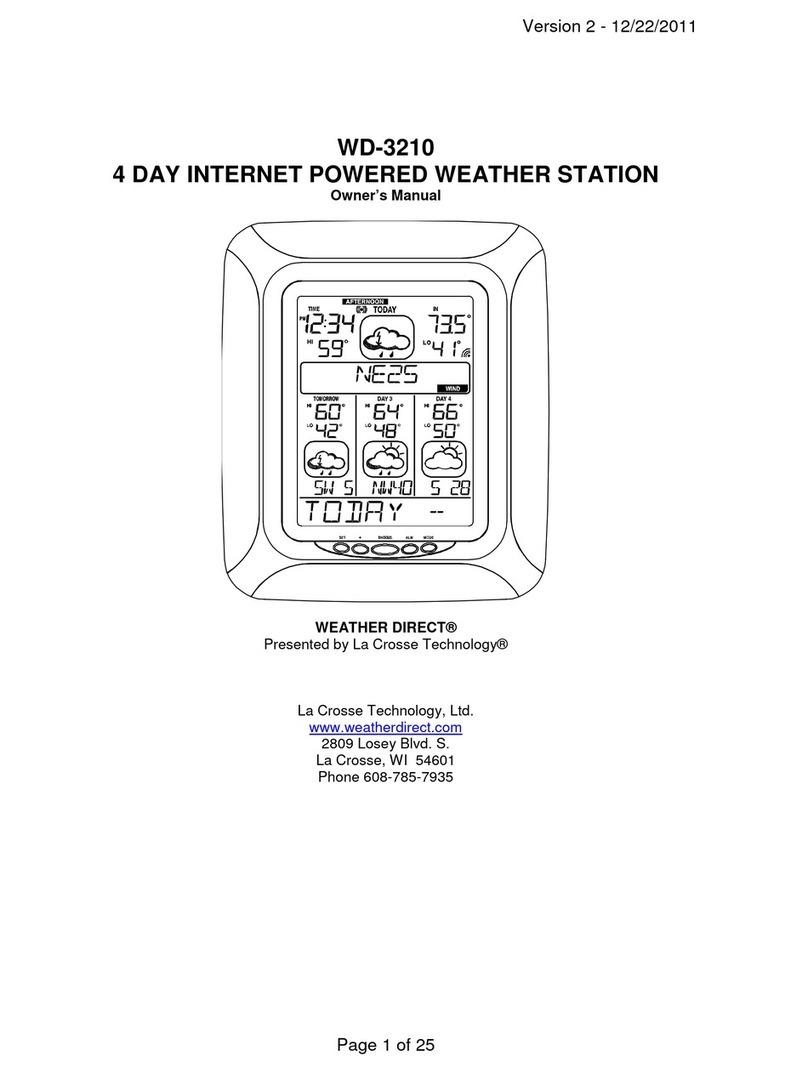
WEATHER TENDENCY INDICATOR (Up or Down arrows): Working together with the
weather icons is the Weather Tendency Indicators. When the Indicator Points Upwards,
it means that the Air-pressure is increasing and the weather is expected to improve, but
when Indicator Points Downwards, the Air-pressure is falling and the weather is
expected to become worse.
CLOTHING INDEX:
Fisherman: The Fisherman Clothing Icon combinations are displayed based on
Outdoor Temperature from the transmitter on channel 1 only. The Fisherman
represents CURRENT TRENDS in Temperature.
COMFORT STATEMENT: The comfort statement is based on the indoor humidity.
WET: Humidity is above 70%
COMFORTABLE: Temperature is between 68°F and 82°F. Humidity is between
40% and 70%
DRY: Humidity is below 40%
MIN/MAX: The forecast station will show the daily minimum and maximum
temperatures each day starting at midnight (12:00 AM). The forecast station
automatically resets the min/max temperatures at midnight (12:00 AM).
View MIN/MAX data: Press and release the MAX/MIN button to view the Maximum,
Minimum, then Current Indoor and Outdoor Temperatures.
Multiple Transmitters: Press and release the CH button to select the desired
outdoor channel to view the Minimum and Maximum Outdoor Temperatures. Press
and release the MAX/MIN button to view the Maximum, Minimum then Current
Temperatures for that channel.
Reset all MIN/MAX data: Hold the MAX/MIN button for 5 seconds and the Indoor
and all Outdoor Minimum and Maximum Temperatures will be reset manually, to
Current temperatures.
LOW BATTERY:
When this icon appears in the indoor (IN) reading section, replace the batteries in
the Forecast Station.
When this icon appears in the outdoor (OUT) readings section, replace the
batteries in the outdoor transmitter.
POSITIONING THE WIRELESS OUTDOOR TRANSMITTER:
Once the Forecast Station shows the outdoor temperature, place it and the transmitter
in the desired locations and wait approximately 1-hour before permanently mounting
the transmitter to ensure that there is proper reception. The transmitter should be
mounted vertically, in a shaded, protected area, at least 6 feet from the ground to avoid
damage and ensure accurate readings. The transmitter is water resistant, not
waterproof and should not be placed anywhere it will become submerged in water or
subject to standing water or snow.
WALL MOUNT:
Choose a shaded location with an overhang for the transmitter, that is
within the confirmed wireless reception range of the Forecast Station for
accuracy.
Install one mounting screw (not included) into a wall leaving
approximately ½ of an inch (12.7mm) extended.
Place the hanging hole (on the back of the transmitter) onto the
mounting screw and gently slide the transmitter down onto the
mounting screw to secure it into place.
IMPORTANT: For true temperature and humidity readings, mount the transmitter out of
direct sunlight on a North-facing wall or in any other well shaded area like under an
eave or deck rail. The maximum transmitting range in open air is over 200-feet (60
meters). Obstacles such as walls, windows, stucco, concrete, and large metal objects
can reduce the range. Place the transmitter at least 6 feet in the air to improve signal
transmission.
SPECIFICATIONS:
Indoor:
Temperature Range: +32°F to +122°F (0°C to 50°C)
Humidity Range: 1%-99% (RH)
Interval: About every 30 seconds
Barometric Pressure: 23.62 to 32.48 inHg (800mb to 1100mb)
Interval: About every 12 minutes
Outdoor:
Temperature Range: -40°F to 140°F (-40°C to 60°C)
Humidity Range: 1%-99% (RH)
Distance: Over 200 ft. (60 meters) RF 433MHz (open air)
Interval: About every 50 seconds
Power:
Wireless Forecast Station: 3-AA, IEC, LR6 batteries (not included)
TX14TH Transmitter: 2-AA, IEC, LR6 batteries (not included)
Battery Life:
TX14TH Transmitter
Battery Life: Battery life is over 24 months when using reputable battery brands.
Wireless Forecast Station
Battery Life: Battery life is over 12 months when using reputable battery brands.
Dimensions:
Wireless Forecast Station: 5.12" L x 2.36" W x 5.12" H (130 x 60 x 130 mm)
TX14TH Transmitter: 2.5" L x 1.42" W x 3.98" H (64 x 36 x 101 mm)
WARRANTY INFORMATION
La Crosse Technology, Ltd provides a 1-year limited warranty on this product against manufacturing
defects in materials and workmanship.
This limited warranty begins on the original date of purchase, is valid only on products purchased and
used in North America and only to the original purchaser of this product. To receive warranty service,
the purchaser must contact La Crosse Technology, Ltd for problem determination and service
procedures. Warranty service can only be performed by a La Crosse Technology, Ltd authorized
service center. The original dated bill of sale must be presented upon request as proof of purchase to
La Crosse Technology, Ltd or La Crosse Technology, Ltd’s authorized service center.
La Crosse Technology, Ltd will repair or replace this product, at our option and at no charge as
stipulated herein, with new or reconditioned parts or products if found to be defective during the limited
warranty period specified above. All replaced parts and products become the property of La Crosse
Technology, Ltd and must be returned to La Crosse Technology, Ltd. Replacement parts and products
assume the remaining original warranty, or ninety (90) days, whichever is longer. La Crosse
Technology, Ltd will pay all expenses for labor and materials for all repairs covered by this warranty. If
necessary repairs are not covered by this warranty, or if a product is examined which is not in need or
repair, you will be charged for the repairs or examination. The owner must pay any shipping charges
incurred in getting the La Crosse Technology, Ltd product to a La Crosse Technology, Ltd authorized
service center. La Crosse Technology, Ltd will pay ground return shipping charges to the owner of the
product to a USA address only.
The La Crosse Technology, Ltd warranty covers all defects in material and workmanship with the
following specified exceptions: (1) damage caused by accident, unreasonable use or neglect (including
the lack of reasonable and necessary maintenance); (2) damage occurring during shipment (claims
must be presented to the carrier); (3) damage to, or deterioration of, any accessory or decorative
surface; (4) damage resulting from failure to follow instructions contained in the owner’s manual; (5)
damage resulting from the performance of repairs or alterations by someone other than an authorized
La Crosse Technology, Ltd authorized service center; (6) units used for other than home use (7)
applications and uses that this product was not intended or (8) the products inability to receive a signal
due to any source of interference.
This warranty covers only actual defects within the product itself, and does not cover the cost of
installation or removal from a fixed installation, normal set-up or adjustments, claims based on
misrepresentation by the seller or performance variations resulting from installation-related
circumstances.
LA CROSSE TECHNOLOGY, LTD WILL NOT ASSUME LIABILITY FOR INCIDENTAL,
CONSEQUENTIAL, PUNITIVE, OR OTHER SIMILAR DAMAGES ASSOCIATED WITH THE
OPERATION OR MALFUNCTION OF THIS PRODUCT. THIS PRODUCT IS NOT TO BE USED FOR
MEDICAL PURPOSES OR FOR PUBLIC INFORMATION. THIS PRODUCT IS NOT A TOY. KEEP
OUT OF CHILDREN’S REACH.
This warranty gives you specific legal rights. You may also have other rights specific to the State.
Some States do not allow the exclusion of consequential or incidental damages therefore the above
exclusion of limitation may not apply to you.
For warranty work, technical support, or information
contact:
La Crosse Technology, Ltd
2817 Losey Blvd. S.
La Crosse, WI 54601
The complete instruction
manual is available at:
www.lacrossetechnology.com/b86012
Contact Support: 1-608-782-1610
Product Registration:
www.lacrossetechnology.com/support/register
Protected under U.S. Patents: 5,978,738, 6,076,044, 6,597,990
FCC Disclaimer:
This Device complies with Part 15 of the FCC Rules. Operation is subject to the following two
conditions: (1) This device may not cause harmful interference, and (2) the device must accept any
interference received, including interference that may cause undesired operation.
NOTE: THE MANUFACTURER IS NOT RESPONSIBLE FOR ANY RADIO OR TV INTERFERENCE
CAUSED BY UNAUTHORIZED MODIFICATIONS TO THIS EQUIPMENT. SUCH MODIFICATIONS
COULD VOID THE USER AUTHORITY TO OPERATE THE EQUIPMENT
All rights reserved. This handbook must not be reproduced in any form, even in excerpts, or duplicated
or processed using electronic, mechanical or chemical procedures without written permission of the
publisher.
This handbook may contain mistakes and printing errors. The information in this handbook is regularly
checked and corrections made in the next issue. We accept no liability for technical mistakes or
printing errors, or their consequences.
All trademarks and patents are acknowledged.
